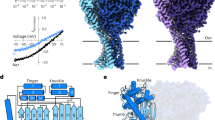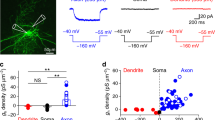Abstract
Sodium-gradient-driven amino acid transport is regarded as an important mechanism for cellular uptake in general as well as in pancreatic acini1–6. Electrophysiological experiments in kidney tubules and intestine have revealed that amino acids can cause sodium-dependent membrane depolarisation7–11. The mechanism of this depolarisation is unknown10 as it is uncertain whether the depolarisation is accompanied by a membrane conductance increase9,11. The pancreatic acinar tissue would seem to be an ideal system for investigating the electrophysiological mechanism of action of amino acids because (1) the pancreas is the most active amino acid-accumulating tissue12, (2) the basic electrophysiology of the pancreatic acinar cells is well characterised13 and (3) a direct comparison can be made in the same cells between the electrical actions of the pancreatic secretagogues and the amino acids. We now show that L-alanine evokes a stereospecific membrane depolarisation accompanied by an increase in membrane conductance and that this membrane effect has a much shorter latency than the secretagogue response. The null (equilibrium) potential for the amino acid-evoked potential change corresponds to the sodium equilibrium potential.
This is a preview of subscription content, access via your institution
Access options
Subscribe to this journal
Receive 51 print issues and online access
$199.00 per year
only $3.90 per issue
Buy this article
- Purchase on Springer Link
- Instant access to full article PDF
Prices may be subject to local taxes which are calculated during checkout
Similar content being viewed by others
References
Crane, R. K. Rev. Physiol. Biochem. Pharmac. 78, 99–159 (1977).
Heinz, E., Geck, P. & Pietrzyk, C. Ann. N.Y. Acad. Sci. 264, 428–441 (1975).
Heinz, E., Geck, P., Pietrzyk, C. & Burchkar, G. J. supramolec. Struct. 6, 125–133 (1977).
Philo, R. D. & Eddy, A. A. Biochem. J. 174, 811–817 (1978).
Villereal, M. L. & Cook, J. S. J. biol. Chem. 253, 8257–8262 (1978).
Tyrakowski, T., Milutinovic, S. & Schulz, I. J. Membrane Biol. 38, 333–346 (1978).
Armstrong, W. McD. & White, J. F. in Electrophysiology of Epithelial Cells (ed. Giebisch, G.) 285–312 (Schathauer, Stuttgart, 1971).
Rose, R. C. & Schultz, S. G. J. gen. Physiol. 57, 639–663 (1971).
Hoshi, T. & Kikuta, Y. in Electrophysiology of the Nephron (ed. Agnostopoulus, T.) 135–150 (INSERM, Paris, 1977).
Okada, Y., Tsuchiya, W., Irimajiri, A. & Inouye, A. J. Membrane Biol. 31, 205–219 (1977).
Frömter, E. J. Physiol., Lond. 288, 1–31 (1979).
Schulz, I. & Ullrich, K. J. in Membrane Transport in Biology Vol. IV (eds Giebisch, G., Tosteson, D. C. & Ussing, H. H.) 811–852 (Springer, Berlin, 1978).
Petersen, O. H. Physiol. Rev. 56, 535–577 (1976).
Iwatsuki, N. & Petersen, O. H. J. Physiol., Lond. 269, 735–751 (1977).
Iwatsuki, N. & Petersen, O. H. J. Cell Biol. 79, 533–545 (1978).
Petersen, O. H. & Philpott, H. G. J. Physiol., Lond. 290, 305–315 (1979).
Nishiyama, A. & Petersen, O. H. J. Physiol. Lond. 244, 431–465 (1975).
Purves, R. D. Nature 261, 149–151 (1976).
Iwatsuki, N. & Petersen, O. H. Nature 268, 147–149 (1977).
Williams, J. A. Am. J. Physiol. 229, 1023–1026 (1975).
Author information
Authors and Affiliations
Rights and permissions
About this article
Cite this article
Iwatsuki, N., Petersen, O. Amino acids evoke short-latency membrane conductance increase in pancreatic acinar cells. Nature 283, 492–494 (1980). https://doi.org/10.1038/283492a0
Received:
Accepted:
Issue Date:
DOI: https://doi.org/10.1038/283492a0
This article is cited by
-
Latency in the inositol lipid transduction pathway: the role of cellular events in responses to thyrotropin-releasing hormone in Xenopus oocytes
Pfl�gers Archiv European Journal of Physiology (1993)
-
Electrogenic properties of the sodium-alanine cotransporter in pancreatic acinar cells: I. Tight-seal whole-cell recordings
The Journal of Membrane Biology (1986)
-
Microscopic description of voltage effects on ion-driven cotransport systems
The Journal of Membrane Biology (1986)
-
l-Alanine andl-phenylalanine activate Na+ and K+ conductance pathways in the exocrine mouse pancreas
Pfl�gers Archiv European Journal of Physiology (1984)
-
Mechanisms of slow postsynaptic potentials
Nature (1981)
Comments
By submitting a comment you agree to abide by our Terms and Community Guidelines. If you find something abusive or that does not comply with our terms or guidelines please flag it as inappropriate.



